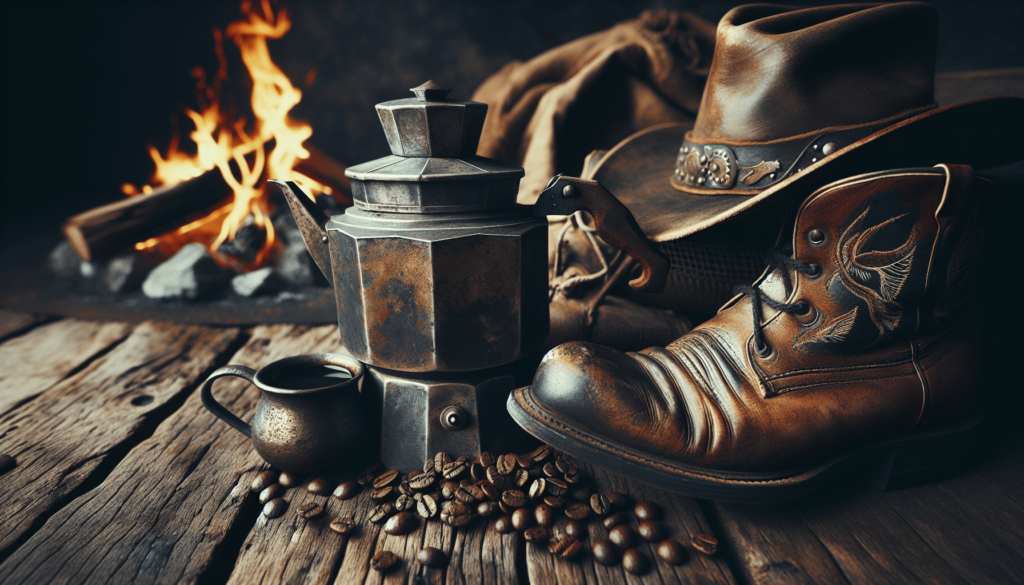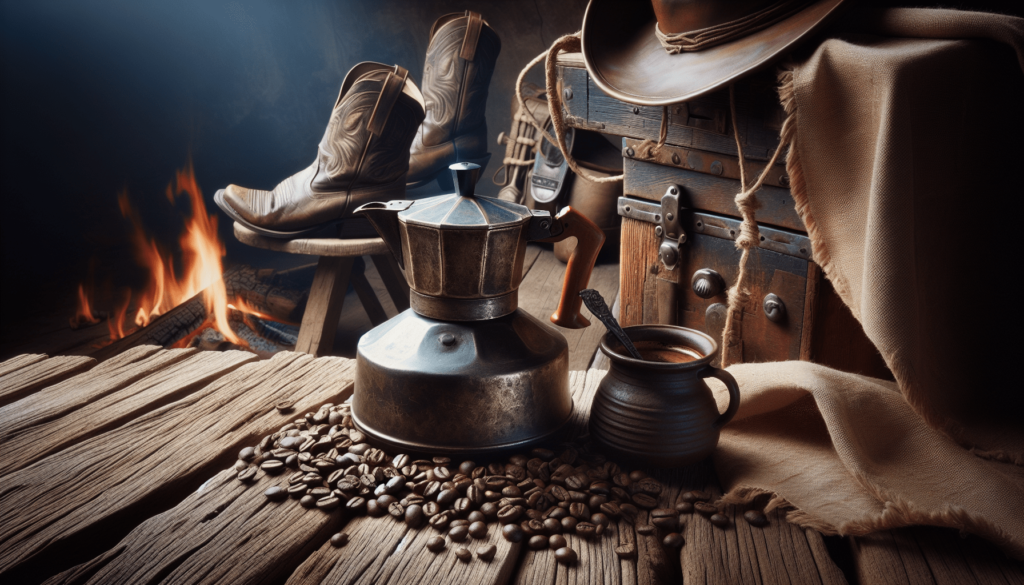Have you ever wondered how to make a cup of coffee that embodies the rugged charm of the Old West? The notion of brewing authentic cowboy coffee has intrigued many, offering not just a caffeinated kick but also a taste of a storied tradition.

What is Cowboy Coffee?
Cowboy coffee is one of the simplest and most traditional methods of brewing coffee. Originating in the American West, it was the drink of choice for cowboys out on the range. With just water, coffee grounds, and a pot, this no-frills method forgoes modern conveniences in favor of raw simplicity.
The History Behind Cowboy Coffee
Back in the days of cattle drives and frontier survival, cowboys didn’t have fancy coffee makers. Instead, they relied on rudimentary methods to brew their morning cup of joe. Using a tin pot over an open fire, they boiled water, threw in coarse coffee grounds, and let nature do the rest. This method was practical, quick, and surprisingly effective.
Essential Ingredients and Tools
Before you get started, you’ll need a few basic ingredients and tools. The aim here is simplicity.
Ingredients
- Coffee Grounds: Use coarse, freshly ground coffee for the best results.
- Water: Clean, fresh water is essential.
Tools
- Coffee Pot or Kettle: An enamel or stainless-steel coffee pot works well.
- Heat Source: An open fire or a camp stove will do the trick.
- Mug: Preferably something rugged.
| Ingredients | Tools | |
|---|---|---|
| Coarse Coffee Grounds | Coffee Pot or Kettle | |
| Fresh Water | Heat Source | |
| – | Mug |
The Cowboy Coffee Brewing Process
Brewing cowboy coffee is straightforward, but a few nuances can make all the difference in achieving that authentic flavor.
Step 1: Measure Your Ingredients
Start by measuring your water and coffee grounds. A general rule of thumb is to use two tablespoons of coffee grounds for every eight ounces of water. Adjust to your taste preference.
Step 2: Heat the Water
Pour the water into your coffee pot or kettle and place it over your heat source. Allow it to come to a rolling boil.
Step 3: Add Coffee Grounds
Once the water reaches a rolling boil, remove the pot from the heat and add your coffee grounds. Stir the mixture briefly to ensure the coffee is fully saturated.
Step 4: Let it Steep
Cover the pot and let the coffee steep for about 3-5 minutes. The longer it steeps, the stronger it will get, so adjust based on your preferred strength.
Step 5: Settle the Grounds
After steeping, gently pour a small amount of cold water over the top. This helps the coffee grounds settle to the bottom of the pot, making it easier to pour your coffee without getting too many grounds in your cup.
Step 6: Pour and Enjoy
Carefully pour your coffee into your mug and savor it. The remaining grounds should stay at the bottom of the pot if you’ve settled them correctly.
Tips and Tricks for the Perfect Cowboy Coffee
To refine your cowboy coffee skills, consider the following tips:
Selecting Your Coffee Beans
The quality of your coffee beans greatly impacts your final brew. Opt for freshly roasted, coarse-ground beans for the best results. The coarser the grind, the better it will withstand boiling without becoming too bitter.
Managing Heat
The temperature of your water is crucial. Too hot, and you risk scalding the coffee; too cold, and you won’t extract enough flavor. Aim to boil the water just until it starts to bubble vigorously, then remove it from the heat immediately before adding the grounds.
Avoiding Gritty Coffee
Nobody enjoys a cup full of coffee grounds. By using coarse grounds and a proper settling technique (like the cold-water trick), you can minimize the grittiness of your cowboy coffee.

Benefits of Cowboy Coffee
Beyond its rich flavor, cowboy coffee comes with several benefits that can’t be ignored.
Simplicity and Minimalism
One of the primary benefits of cowboy coffee is its simplicity. With just a few basic ingredients and tools, you can make a satisfying cup of coffee anywhere.
Rich, Bold Flavor
Cowboy coffee offers a uniquely rich and bold flavor that can be hard to replicate with other brewing methods. The direct contact between the grounds and boiling water extracts a robust profile that’s hard to beat.
Versatility
Whether you’re camping, at home, or just want to try something different, cowboy coffee is versatile and adaptable to various settings.
Common Mistakes and How to Avoid Them
Even though cowboy coffee is simple to make, it’s easy to make mistakes. Here’s how to avoid common pitfalls.
Using Too Fine Grounds
Fine coffee grounds can make your brew overly bitter and result in a gritty texture. Stick to coarse-ground coffee for the best outcome.
Over-Boiling the Water
Boiling the water too long can scald the coffee, resulting in a burnt or bitter taste. Remove the water from the heat as soon as it reaches a rolling boil.
Skipping the Steep Time
Rushing the steeping process can leave your coffee under-extracted and weak. Allow ample time for the grounds to steep.
Variations and Flavor Enhancements
If you feel adventurous or just want to mix things up, there are several variations and enhancements you can try with your cowboy coffee.
Add a Pinch of Salt
Some swear by adding a pinch of salt to the coffee grounds to reduce bitterness and enhance flavor.
Include Spices
For a unique twist, consider adding spices like cinnamon or nutmeg to your coffee grounds. These can introduce new, interesting flavors to your cowboy coffee.
Try Alternative Sweeteners
If you want a touch of sweetness, try adding natural sweeteners like honey or maple syrup. Both complement the bold flavors of cowboy coffee well.
Environmental Impact of Cowboy Coffee
One of the great things about cowboy coffee is its minimal environmental impact compared to other methods.
No Disposable Filters
Cowboy coffee eliminates the need for disposable filters, reducing waste compared to other brewing methods.
Minimal Equipment
The simplicity of cowboy coffee means less equipment and fewer materials, making it a more sustainable option.
Biodegradable Grounds
Used coffee grounds are biodegradable and can be composted, giving back to the earth rather than accumulating in a landfill.
FAQs About Cowboy Coffee
Here are some frequently asked questions to deepen your understanding of cowboy coffee.
Can I Make Cowboy Coffee Indoors?
Absolutely! While traditionally made over an open fire, you can achieve the same results on a stovetop or even a hot plate.
What Type of Pot is Best for Cowboy Coffee?
An enamel or stainless-steel pot is often recommended as these materials withstand high heat well and are easy to clean.
How Do You Measure Coffee for Cowboy Coffee?
A standard ratio is two tablespoons of coffee grounds per eight ounces of water, but feel free to adjust based on your taste preferences.
Can You Reuse Coffee Grounds?
Technically, you can, but reusing grounds can result in a weaker and potentially bitter brew. Fresh grounds are always best.
Is Cowboy Coffee Stronger than Regular Coffee?
Due to the longer steeping time and direct contact with boiling water, cowboy coffee can be stronger and more robust in flavor compared to regular drip coffee.
Conclusion
Mastering the art of authentic cowboy coffee is about more than just brewing a drink; it’s about connecting with a tradition. With the right ingredients, tools, and techniques, you can enjoy a cup of coffee that not only wakes you up but also brings a piece of frontier spirit into your modern life. So, gather your ingredients, find a heat source, and let the aroma of cowboy coffee transport you back to the open plains and clear skies of the Wild West.
